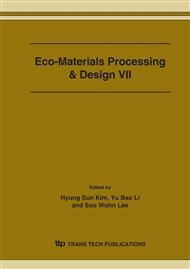p.822
p.826
p.830
p.834
p.838
p.842
p.846
p.850
p.854
Tribological Analysis of Al2O3/TiO2/ZrO2 Nanocomposites as an Alternative for THR Materials
Abstract:
This work studied the microstructure and tribological behavior of Al2O3/TiO2/ZrO2 nanocomposites to be used in hip joint replacements. To increase the fracture toughness of alumina and enhance the tribological properties, nanometer sized particles of TiO2 and ZrO2 were added. The specimens contained 10 mol% of TiO2, different percentages of ZrO2 (0, 2.5, 5, 7.5, 15 and 20 mol %), and alumina as a remainder. Disks were hot pressed at 1500 °C and 25 MPa, in an Argon atmosphere for 1 hour. Given the fact that the sample containing 7.5 mol% of ZrO2 showed the lowest wear volume, it was hot pressed again at 1500, 1400, 1300 and 1200 °C to assess the best temperature condition for sintering. For a composition of 7.5 mol% of ZrO2 the lowest coefficient of friction (0.1-0.3) and the lowest wear volume (0.0046 mm3) were achieved. A direct relation between mechanical and tribological properties was not found. However, these nanocomposites may be considered as a candidate for a new generation of hip joint replacement material.
Info:
Periodical:
Pages:
838-841
Citation:
Online since:
March 2006
Keywords:
Price:
Сopyright:
© 2006 Trans Tech Publications Ltd. All Rights Reserved
Share:
Citation:


